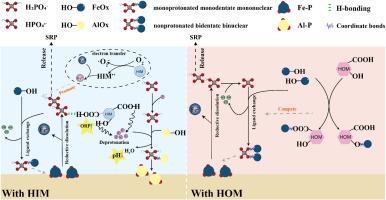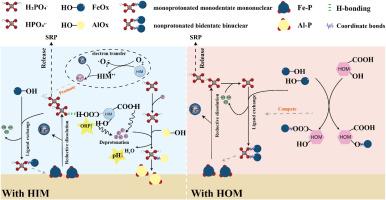疏水和亲水溶解有机物:通过多方面表征揭示其对沉积物磷释放影响的机理
IF 10
1区 环境科学与生态学
Q1 ENGINEERING, ENVIRONMENTAL
引用次数: 0
摘要
溶解性有机物(DOM)在水生生态系统中磷(P)循环中的作用是必不可少的。据我们所知,目前还没有研究在分子水平上考察DOM的亲水性(HIM)和疏水性(HOM)部分对P释放的影响。在这项工作中,采用傅里叶变换红外光谱(FTIR)、电子顺磁共振(EPR)、碳-13核磁共振(13C NMR)、元素分析(EA)和傅里叶变换离子回旋共振质谱联用电喷雾电离(ESI-FT-ICR-MS)对两组DOM组分的表征进行了更深入的研究。然后设计培养实验来分析它们对可溶性磷(SRP)释放的影响。在此,我们证明了HIM和HOM在沉积物P释放中的明显不同作用。添加HIM抑制SRP从沉积物中释放,而HOM促进SRP从沉积物中释放。机理分析表明,在抑制铁结合磷的释放过程中,HIM上的羧基和羟基以及HIM产生的超氧自由基(•O2−)起着关键作用。培养实验结果表明,HOM处理的最大释放量和平均通量分别为2.35 mg/kg和0.66 mg/(m2·d), SRP的释放量比对照增加了73.17%。相比之下,在HIM处理中,数值分别为0.28 mg/kg和0.10 mg/(m2·d),表明下降79.08%。因此,未来的工作应侧重于利用HIM去除P的能力,同时优先消除HOM。本研究在分子水平上揭示了HIM和HOM对水生生态系统磷释放的影响,为有效管理水生生态系统磷循环提供了科学依据。本文章由计算机程序翻译,如有差异,请以英文原文为准。


Hydrophobic and hydrophilic dissolved organic matter: Mechanistic insights into its influence on sediment phosphorus release revealed through multifaceted characterization
The role of dissolved organic matter (DOM) in phosphorus (P) cycling in aquatic ecosystems is essential. To the best of our knowledge, no study has yet examined the impacts of the hydrophilic (HIM) and hydrophobic (HOM) fractions of DOM on P release at the molecular level. In this work, Fourier transform infrared spectroscopy (FTIR), electron paramagnetic resonance (EPR), carbon-13 nuclear magnetic resonance (13C NMR), elemental analysis (EA), and Fourier transform ion cyclotron resonance mass spectrometry coupled with electrospray ionization (ESI-FT-ICR-MS) were employed to gain deeper insights into the characterization of two sets of DOM fractions. Incubation experiments were then designed to analyse their impact on soluble phosphorus (SRP) release. Herein, we demonstrated the distinctly different roles of HIM and HOM in P release from sediments. Adding HIM inhibited SRP release from the sediment, whereas HOM promoted it. Mechanism diagrams illustrated that the carboxyl and hydroxyl groups on HIM, along with the superoxide radical ions (•O2−) produced by HIM, play a critical role in suppressing the release of Fe-bound P. Furthermore, the results of the incubation experiments indicated that the maximum release and average flux in the HOM treatment were 2.35 mg/kg and 0.66 mg/(m2·d), respectively, representing a 73.17 % increase in SRP release compared to the control. In contrast, in the HIM treatment, the values were 0.28 mg/kg and 0.10 mg/(m2·d), respectively, indicating a 79.08 % decrease. Therefore, future efforts should focus on leveraging the P removal capacity of HIM while prioritizing the elimination of HOM. Our study uncovers the effects of HIM and HOM on P release at the molecular level, offering a scientific foundation for effective management of P cycling in aquatic ecosystems.
求助全文
通过发布文献求助,成功后即可免费获取论文全文。
去求助
来源期刊

Journal of Cleaner Production
环境科学-工程:环境
CiteScore
20.40
自引率
9.00%
发文量
4720
审稿时长
111 days
期刊介绍:
The Journal of Cleaner Production is an international, transdisciplinary journal that addresses and discusses theoretical and practical Cleaner Production, Environmental, and Sustainability issues. It aims to help societies become more sustainable by focusing on the concept of 'Cleaner Production', which aims at preventing waste production and increasing efficiencies in energy, water, resources, and human capital use. The journal serves as a platform for corporations, governments, education institutions, regions, and societies to engage in discussions and research related to Cleaner Production, environmental, and sustainability practices.
 求助内容:
求助内容: 应助结果提醒方式:
应助结果提醒方式:


